technical data Seat Altea Freetrack 2010 Service Manual
[x] Cancel search | Manufacturer: SEAT, Model Year: 2010, Model line: Altea Freetrack, Model: Seat Altea Freetrack 2010Pages: 294, PDF Size: 7.71 MB
Page 85 of 294

Cockpit83
Safety First
Controls and equipment
Practical tips
Technical Data
assistance. The power steering does not work if the battery is flat or if the
engine is off (for example, for towing). You should take into account that you
will need considerably more power than normal to steer the vehicle if the
steering assistance is reduced or has failed completely.
For those vehicles fitted with ESP* the function “Recommended steering
manoeuvre” is included. See
⇒page 185.
Emission control system*
This warning lamp monitors the exhaust system.
Warning lamp
flashes:
When there is misfiring that can damage the catalytic converter. Reduce
speed and drive carefully to the nearest qualified workshop to have the
engine checked.
The dash panel displays the following message
16): EXHAUST GAS SEE
WORKSHOP
Warning lamp
is lit:
If a fault has developed during driving which has reduced the quality of the
exhaust gas (e.g. lambda probe fault). Reduce speed and drive carefully to
the nearest qualified workshop to have the engine checked.
The following information text displayed in the dash panel display : EXHAUST
GAS SEE WORKSHOP .
Electronic stabilisation programme (ESP)*
This warning lamp monitors the electronic stabilisation
programme.
This programme includes the ABS, EDL and TCS. This also includes the brake
assist system (BAS), automatic cleaning of the brake discs and the trailer
stability programme (TSP).
The warning lamp
has the following functions:
•It will light for about 2 seconds when the ignition is switched on while a
test of the function is carried out.•It flashes when the ESP is activated when driving.•It will light up continuously if there is a malfunction in the ESP.•It will also come on if a fault should occur in the ABS because the ESP
operates in conjunction with the ABS.
If the ESP warning lamp
lights up and stays on after the engine is started,
this may mean that the control system has temporarily switched off the ESP.
In this case the ESP can be reactivated by switching the ignition off and then
on again. If the warning lamp goes out, this means the system is fully func-
tional.
If the ESP button is activated, the TCS function deactivates and the warning
lamp flashes.
16)Depending on the version of the model.
Freetrack_EN.book Seite 83 Donnerstag, 10. September 2009 10:33 10
Page 87 of 294
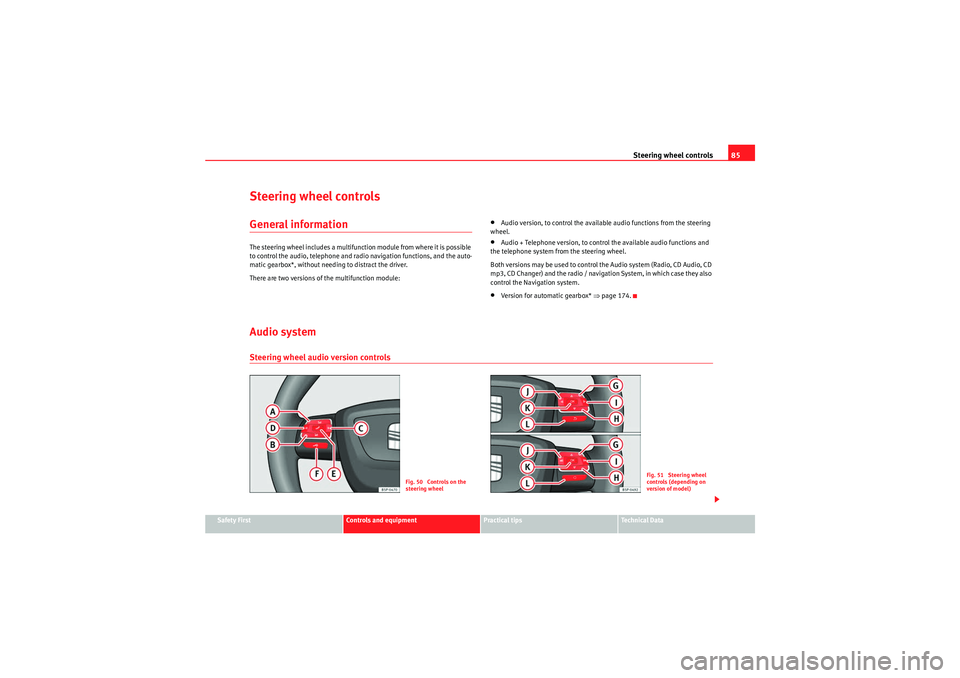
Steering wheel controls85
Safety First
Controls and equipment
Practical tips
Technical Data
Steering wheel controlsGeneral informationThe steering wheel includes a multifunction module from where it is possible
to control the audio, telephone and radio navigation functions, and the auto-
matic gearbox*, without needing to distract the driver.
There are two versions of the multifunction module:
•Audio version, to control the available audio functions from the steering
wheel.•Audio + Telephone version, to control the available audio functions and
the telephone system from the steering wheel.
Both versions may be used to control the Audio system (Radio, CD Audio, CD
m p3, CD Changer) and the radio / navigation System, in which case they also
control the Navigation system.•Version for automatic gearbox* ⇒page 174.
Audio systemSteering wheel audio version controls
Fig. 50 Controls on the
steering wheel
Fig. 51 Steering wheel
controls (depending on
version of model)
Freetrack_EN.book Seite 85 Donnerstag, 10. September 2009 10:33 10
Page 89 of 294

Steering wheel controls87
Safety First
Controls and equipment
Practical tips
Technical Data
Steering wheel Audio + Telephone version controls
Fig. 52 Controls on the
steering wheel
Fig. 53 Steering wheel
controls (depending on
version of model)
Button
Radio
CD/MP3/USB*/iPod*
AUX
TELEPHONE
Volume up
Vol um e up
Volu m e up
Vol um e u p
Volu m e dow n
Volu m e d own
Vol um e d own
Volu m e d own
Search for next station
Next track
Hold down: Fast forward
No function specified
No function specified
Search for last station
Last track
Hold down:Rewind
No function specified
No function specified
Access telephone menu on instrument panel
Access telephone menu on instrument panel
Access telephone menu on instrument panel
Make call
Accept incoming call End call
Hold down: reject incoming call
Enable voice recognition
Enable voice recognition
Enable voice recognition
Enable voice recognition
AAABACADAEAF
Freetrack_EN.book Seite 87 Donnerstag, 10. September 2009 10:33 10
Page 91 of 294

Steering wheel controls89
Safety First
Controls and equipment
Practical tips
Technical Data
Radio navigation systemSteering wheel audio version controls
Fig. 54 Controls on the
steering wheel
Fig. 55 Steering wheel
controls (depending on
version of model)
Button
Radio
CD/MP3/USB*/iPod*
AUX
NAVIGATOR
Volume up
Vol um e up
Volu m e up
Vol um e u p
Volu m e dow n
Volu m e d own
Vol um e d own
Volu m e d own
Search for next station
Next track
Hold down: Fast forward
No function specified
No function specified
Search for last station
Last track
Hold down:Rewind
No function specified
No function specified
Access telephone menu on instrument panel
Access telephone menu on instrument panel
Access telephone menu on instrument panel
No function specified
Enable voice recognition
Enable voice recognition
Enable voice recognition
Enable voice recognition
AAABACADAEAF
Freetrack_EN.book Seite 89 Donnerstag, 10. September 2009 10:33 10
Page 93 of 294

Steering wheel controls91
Safety First
Controls and equipment
Practical tips
Technical Data
Button
Radio
CD/MP3/USB*/iPod*
AUX
NAVIGATOR
TELEPHONE
Vol um e up
Vol um e up
Vol um e up
Volume up
Volu m e up
Volume down
Volume down
Volume down
Vol um e d own
Volu m e d own
Search for next station
Next track
Hold down: Fast forward
No function specified
No function specified
No function specified
Search for last station
Last track
Hold down:Rewind
No function specified
No function specified
No function specified
Access telephone menu on instrument panel
Access telephone menu on instrument panel
Access telephone menu on instrument panel
No function specified
Make call
Accept incoming call End call
Hold down: reject incoming call
Enable voice recognition
Enable voice recognition
Enable voice recognition
Enable voice recogni-tion
Enable voice recognition
Next preset
a)
Next track
a)
No function specified
Operates on instru-ment panel
Movement on telephone menu
Address book / Last calls /
Calls received / Missed calls
Previous preset
a)
Previous track
a)
No function specified
Operates on instru- ment panel
Movement on telephone menu
Address book / Last calls /
Calls received / Missed calls
Change menu on instrument panel
Change menu on instrument panel
Change menu on instru-ment panel
No function specified
Change menu on instru-ment panel
AAABACADAEAFAGAHAI
Freetrack_EN.book Seite 91 Donnerstag, 10. September 2009 10:33 10
Page 95 of 294
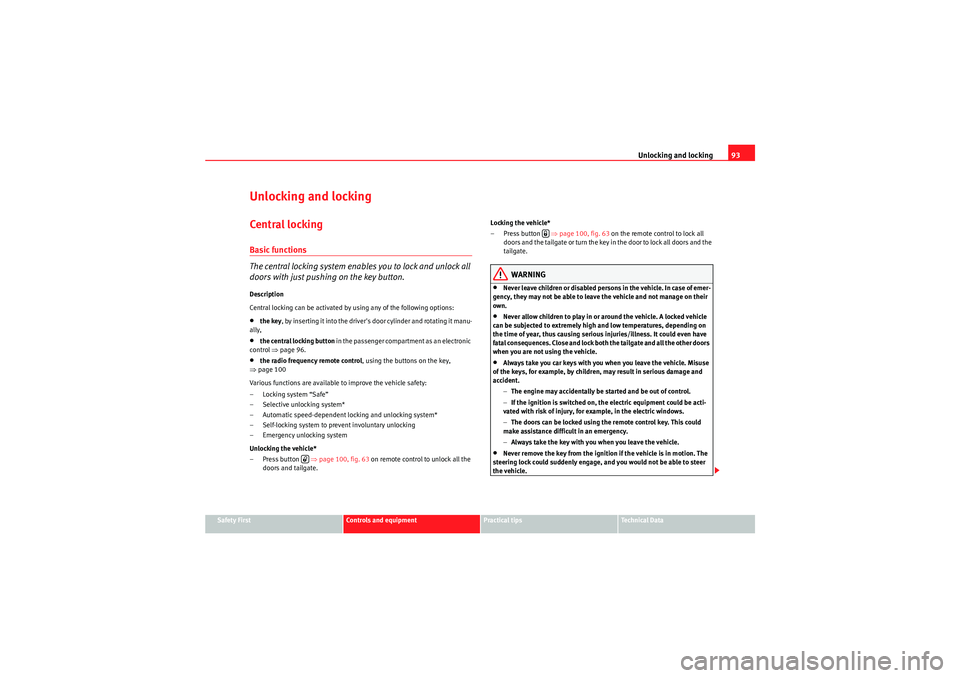
Unlocking and locking93
Safety First
Controls and equipment
Practical tips
Technical Data
Unlocking and lockingCentral lockingBasic functions
The central locking system enables you to lock and unlock all
doors with just pushing on the key button.Description
Central locking can be activated by using any of the following options:•the key, by inserting it into the driver's door cylinder and rotating it manu-
ally,•the central locking button in the passenger compartment as an electronic
control ⇒page 96.•the radio frequency remote control , using the buttons on the key,
⇒ page 100
Various functions are available to improve the vehicle safety:
– Locking system “Safe”
– Selective unlocking system*
– Automatic speed-dependent locking and unlocking system*
– Self-locking system to prevent involuntary unlocking
– Emergency unlocking system
Unlocking the vehicle*
–Press button ⇒page 100, fig. 63 on remote control to unlock all the
doors and tailgate. Locking the vehicle*
– Press button
⇒page 100, fig. 63 on the remote control to lock all
doors and the tailgate or turn the key in the door to lock all doors and the
tailgate.
WARNING
•Never leave children or disabled persons in the vehicle. In case of emer-
gency, they may not be able to leave the vehicle and not manage on their
own.•Never allow children to play in or around the vehicle. A locked vehicle
can be subjected to extremely high and low temperatures, depending on
the time of year, thus causing serious injuries/illness. It could even have
fatal consequences. Close and lock both the tailgate and all the other doors
when you are not using the vehicle.•Always take you car keys with you when you leave the vehicle. Misuse
of the keys, for example, by children, may result in serious damage and
accident.
−The engine may accidentally be started and be out of control.
− If the ignition is switched on, the electric equipment could be acti-
vated with risk of injury, for example, in the electric windows.
− The doors can be locked using the remote control key. This could
make assistance difficult in an emergency.
− Always take the key with you when you leave the vehicle.•Never remove the key from the ignition if the vehicle is in motion. The
steering lock could suddenly engage, and you would not be able to steer
the vehicle.
Freetrack_EN.book Seite 93 Donnerstag, 10. September 2009 10:33 10
Page 97 of 294
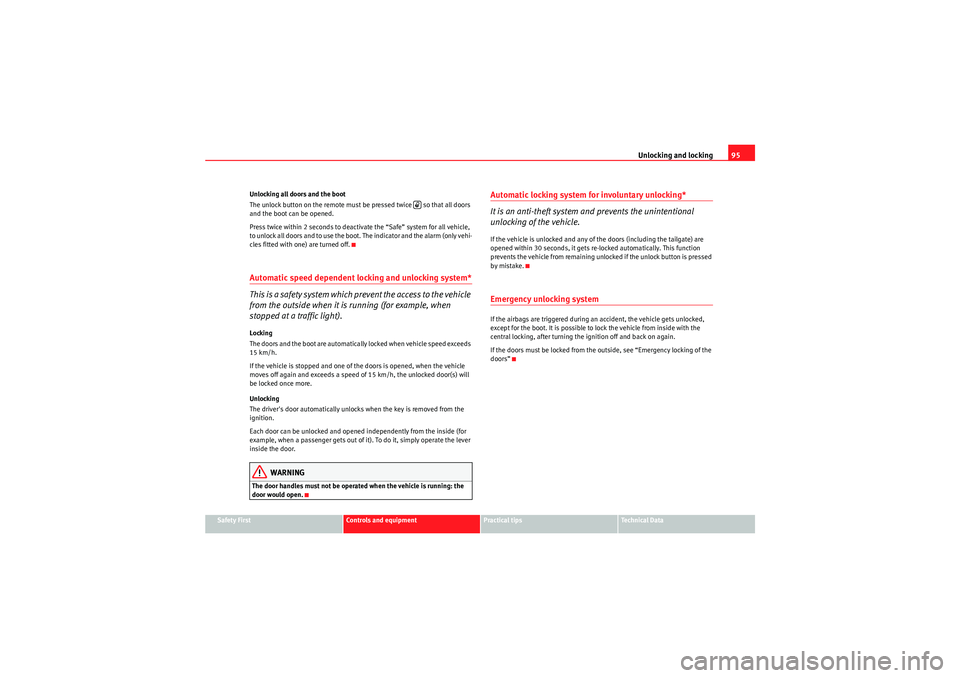
Unlocking and locking95
Safety First
Controls and equipment
Practical tips
Technical Data
Unlocking all doors and the boot
The unlock button on the remote must be pressed twice so that all doors
and the boot can be opened.
Press twice within 2 seconds to deactivate the “Safe” system for all vehicle,
to unlock all doors and to use the boot. The indicator and the alarm (only vehi-
cles fitted with one) are turned off.
Automatic speed dependent locking and unlocking system*
This is a safety system which
prevent the access to the vehicle
from the outside when it is running (for example, when
stopped at a traffic light).Locking
The doors and the boot are automatically locked when vehicle speed exceeds
15 km/h.
If the vehicle is stopped and one of the doors is opened, when the vehicle
moves off again and exceeds a speed of 15 km/h, the unlocked door(s) will
be locked once more.
Unlocking
The driver's door automatically unlocks when the key is removed from the
ignition.
Each door can be unlocked and opened independently from the inside (for
example, when a passenger gets out of it). To do it, simply operate the lever
inside the door.
WARNING
The door handles must not be operated when the vehicle is running: the
door would open.
Automatic locking system for involuntary unlocking*
It is an anti-theft system and prevents the unintentional
unlocking of the vehicle.If the vehicle is unlocked and any of the doors (including the tailgate) are
opened within 30 seconds, it gets re-locked automatically. This function
prevents the vehicle from remaining unlocked if the unlock button is pressed
by mistake.Emergency unlocking systemIf the airbags are triggered during an accident, the vehicle gets unlocked,
except for the boot. It is possible to lock the vehicle from inside with the
central locking, after turning the ignition off and back on again.
If the doors must be locked from the outside, see “Emergency locking of the
doors”
Freetrack_EN.book Seite 95 Donnerstag, 10. September 2009 10:33 10
Page 99 of 294

Unlocking and locking97
Safety First
Controls and equipment
Practical tips
Technical Data
Deactivating selective unlocking
With the driver's door open, turn the key to lock for approx. 3 s
The indicator lamps flash to confirm activation or deactivation.
Activation of automatic locking
Press the lock button on the central locking button for 3 seconds.
Deactivation of automatic locking
Press the unlock button on the central locking button for 3 seconds.
The lock button lamp flashes to confirm activation or deactivation.
Emergency manual locking
This permits mechanical locking of the doors in case of
central locking system failure.
Locking the driver's door manually
Insert the key in the door lock cylinder and rotate in a clockwise direction for
the left hand side door and anti-clockwise for the right hand side door.
Once the door has been closed it can no longer be opened from the outside.
Manual (emergency) locking of the remaining doors
Open the door and remove the cap
⇒fig. 59 printed with a lock image.
This will expose a circular element with a groove in the centre. Insert the key
into the groove and rotate the element clockwise for the right hand side doors
and anticlockwise for the left hand side doors.
Replace the cap and close the door. Once the door has been closed it can no
longer be opened from the outside.
Unlocking the manually (emergency) locked driver's door
Insert the key in the door lock cylinder and rotate anti-clockwise for the left
hand side doors and clockwise for the right hand side doors.
T h e do or lo ck is r eleas ed a nd th e do or m ay b e op e ne d using the ex te r io r do o r
handle.
Unlocking the remaining manually (emergency) locked doors
First the driver's door must be unlocked to gain entry to the vehicle. Operate
the internal door handle for the required door. If the child safety lock is acti-
vated on the rear doors, when the interior door release lever is operated the
door is unlocked but does not open. The exterior door handle may now be
used to open the door.
Note
Once the vehicle is open, if you wish to lock it manually (emergency locking),
repeat the previous instructions.
Fig. 59 Locking the doors
manually
AA
Freetrack_EN.book Seite 97 Donnerstag, 10. September 2009 10:33 10
Page 101 of 294
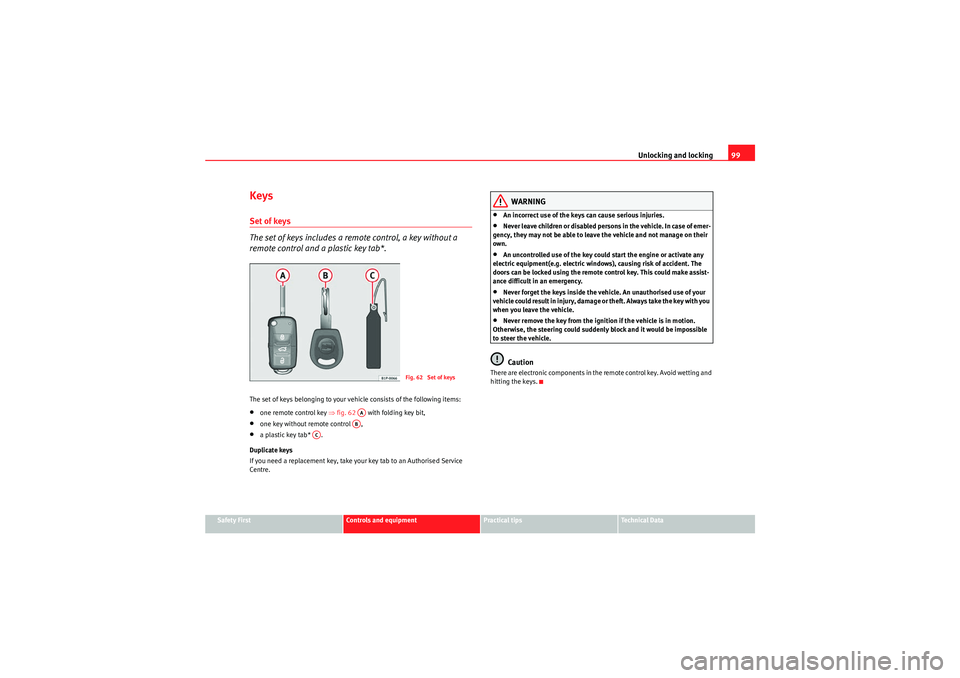
Unlocking and locking99
Safety First
Controls and equipment
Practical tips
Technical Data
KeysSet of keys
The set of keys includes a remote control, a key without a
remote control and a plastic key tab*.The set of keys belonging to your vehicle consists of the following items:•one remote control key ⇒fig. 62 with folding key bit,•one key without remote control ,•a plastic key tab* .
Duplicate keys
If you need a replacement key, take your key tab to an Authorised Service
Centre.
WARNING
•An incorrect use of the keys can cause serious injuries.•Never leave children or disabled persons in the vehicle. In case of emer-
gency, they may not be able to leave the vehicle and not manage on their
own.•An uncontrolled use of the key could start the engine or activate any
electric equipment(e.g. electric windows), causing risk of accident. The
doors can be locked using the remote control key. This could make assist-
ance difficult in an emergency.•Never forget the keys inside the vehicle. An unauthorised use of your
vehicle could result in injury, damage or theft. Always take the key with you
when you leave the vehicle.•Never remove the key from the ignition if the vehicle is in motion.
Otherwise, the steering could suddenly block and it would be impossible
to steer the vehicle.Caution
There are electronic components in the remote control key. Avoid wetting and
hitting the keys.
Fig. 62 Set of keys
AAAB
AC
Freetrack_EN.book Seite 99 Donnerstag, 10. September 2009 10:33 10
Page 103 of 294
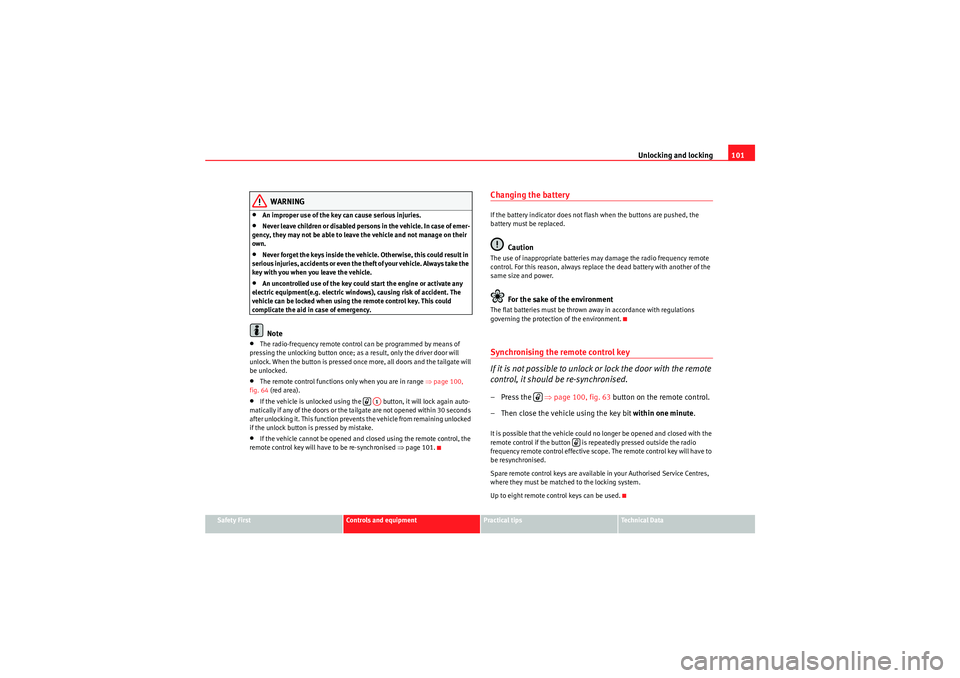
Unlocking and locking101
Safety First
Controls and equipment
Practical tips
Technical Data
WARNING
•An improper use of the key can cause serious injuries.•Never leave children or disabled persons in the vehicle. In case of emer-
gency, they may not be able to leave the vehicle and not manage on their
own.•Never forget the keys inside the vehicle. Otherwise, this could result in
serious injuries, accidents or even the theft of your vehicle. Always take the
key with you when you leave the vehicle.•An uncontrolled use of the key could start the engine or activate any
electric equipment(e.g. electric windows), causing risk of accident. The
vehicle can be locked when using the remote control key. This could
complicate the aid in case of emergency.Note
•The radio-frequency remote contro l can be programmed by means of
pressing the unlocking button once; as a result, only the driver door will
unlock. When the button is pressed once more, all doors and the tailgate will
be unlocked.•The remote control functions only when you are in range ⇒page 100,
fig. 64 (red area).•If the vehicle is unlocked using the button, it will lock again auto-
matically if any of the doors or the tailgate are not opened within 30 seconds
after unlocking it. This function prevents the vehicle from remaining unlocked
if the unlock button is pressed by mistake.•If the vehicle cannot be opened and closed using the remote control, the
remote control key will have to be re-synchronised ⇒page 101.
Changing the batteryIf the battery indicator does not flash when the buttons are pushed, the
battery must be replaced.
Caution
The use of inappropriate batteries may damage the radio frequency remote
control. For this reason, always replace the dead battery with another of the
same size and power.
For the sake of the environment
The flat batteries must be thrown away in accordance with regulations
governing the protection of the environment.Synchronising the remote control key
If it is not possible to unlock or lock the door with the remote
control, it should be re-synchronised.–Press the ⇒page 100, fig. 63 button on the remote control.
– Then close the vehicle using the key bit within one minute.It is possible that the vehicle could no longer be opened and closed with the
remote control if the button is repeatedly pressed outside the radio
frequency remote control effective scope. The remote control key will have to
be resynchronised.
Spare remote control keys are available in your Authorised Service Centres,
where they must be matched to the locking system.
Up to eight remote control keys can be used.
A1
Freetrack_EN.book Seite 101 Donnerstag, 10. September 2009 10:33 10